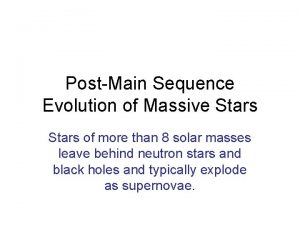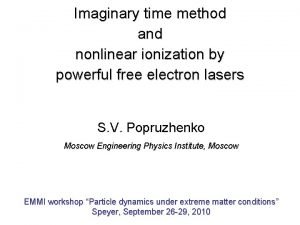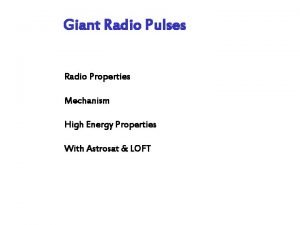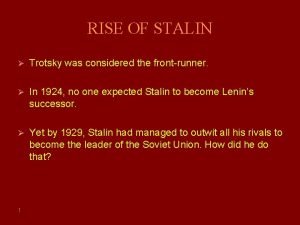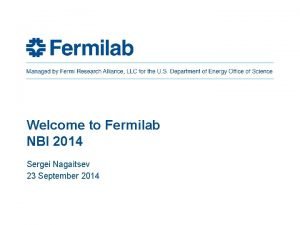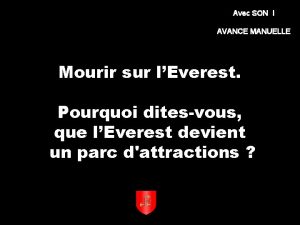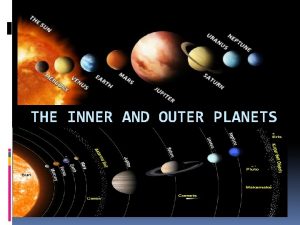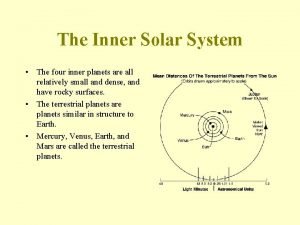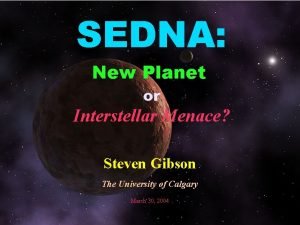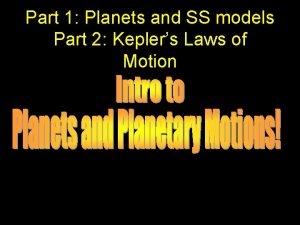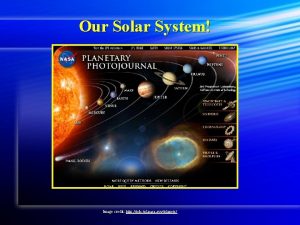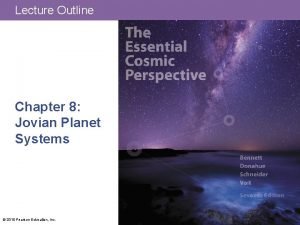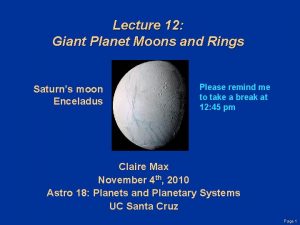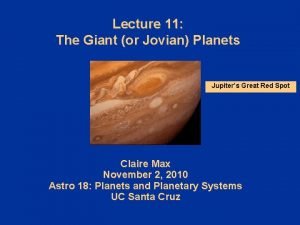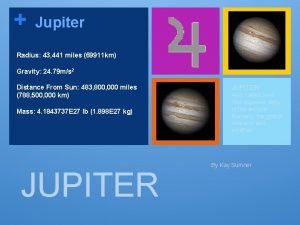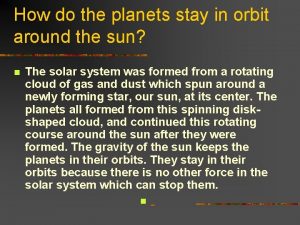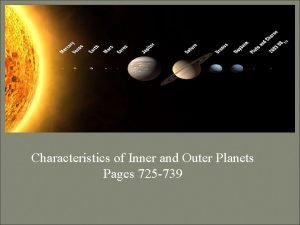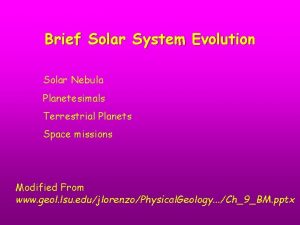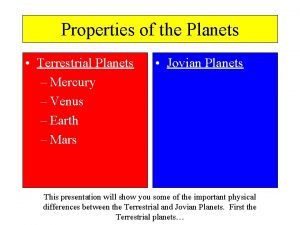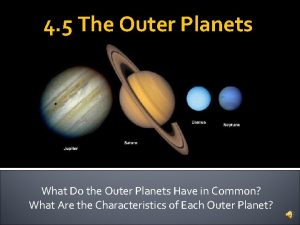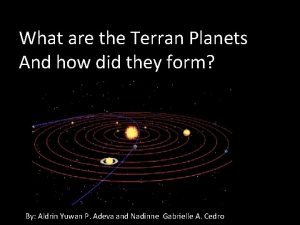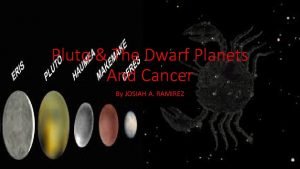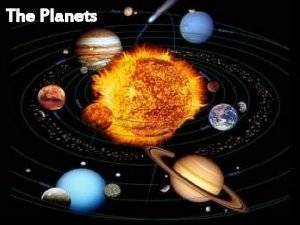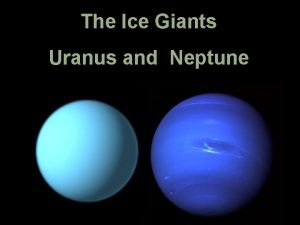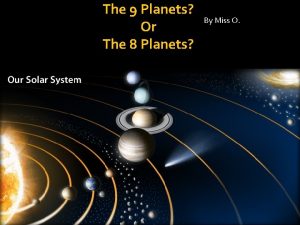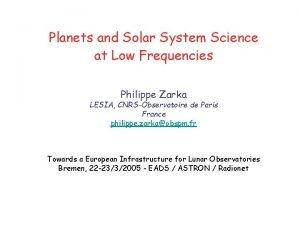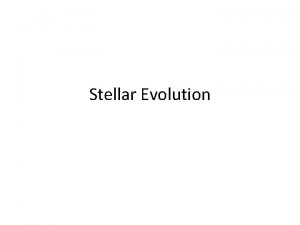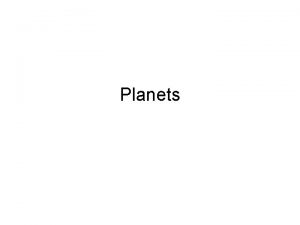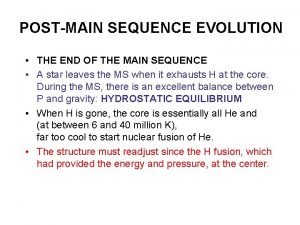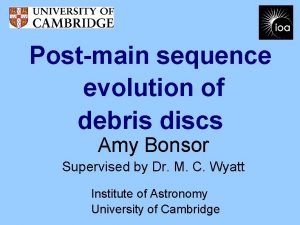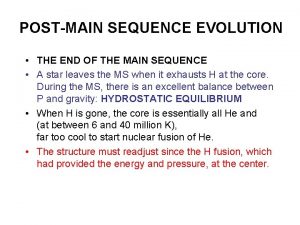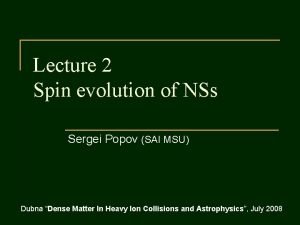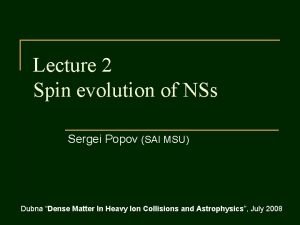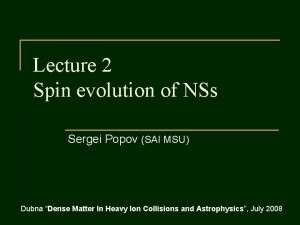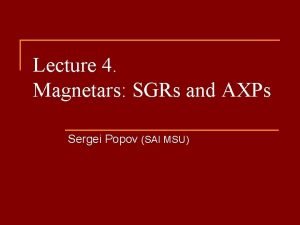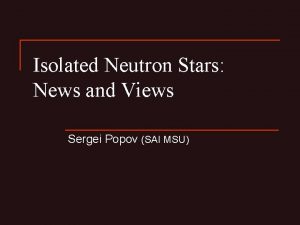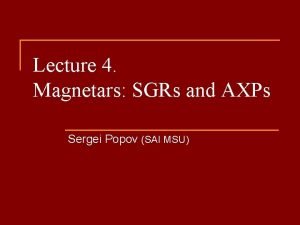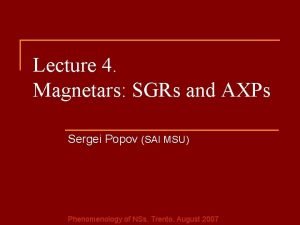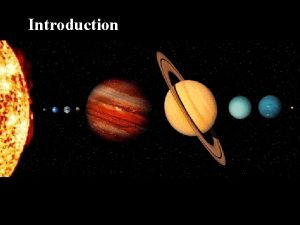Postmain sequence evolution and planets SERGEI POPOV PostMS

































































- Slides: 65

Post-main sequence evolution and planets SERGEI POPOV

Post-MS evolution Stellar evolution influences the planetary system. Expansion of the star, mass loss, tides – all modifies planetary orbits. Planets are observed around red giants, in evolved binary systems, and even around white dwarfs and neutron stars.

Physical effects and processes: Giant stars Veras (2016) 1601. 05419

Physical effects and processes: WDs and NSs Veras (2016)

Specific post-MS systems Some peculiar (at first glance) systems can shed light on important issues of stellar and planetary evolution. Veras (2016)

Iben (1991) Stellar evolution Veras (2016)

Stars and white dwarfs Blöcker (1995) Veras (2016)

Thermal evolution of WDs The code by Blinnikov and Dunina-Barkovskaya (1994). Popov et al. (2018)

Stellar mass vs. white dwarf mass 1809. 01673

Mass loss after the Main sequence Veras (2016) Mass loss at the red giant branch (modified Reimers formula) RGB and AGB for P<100 days AGB for P > 100 days Mass loss after the RGB is uncertain. It is not constant due to pulsation. At the tip of the AGB Mdot can reach 0. 0001 solar mass per year. At the AGB MZAMS can be modified to MCURRENT Blöcker (1995)

Mass loss 1809. 01673

Orbital evolution with mass loss General formula Veras (2016)


Numerical results β=0 β=3 1303. 3841 e=0. 316

Numerical results β=3 β=-0. 5 1303. 3841

Adiabatic regime: simple solution Adiabatic regime – easy to analyze. Eccentricity is constant and so: (1/a) Most of planet are in these regime (a<100 AU). Veras (2016)

Gas drag in the wind atmosphere Small bodies can be destroyed by the wind or in atmosphere. Veras (2016)

Tides Actually, many different approaches to calculate tidal effects are used. Veras (2016)



Tidal engulfment: RGB star 1. 5 solar mass at the Main sequence. Jupiter mass planet. Veras (2016)

Tidal engulfment: AGB star 2 solar mass at the MS. Veras (2016)

Planets around red giants >100 planets http: //www. astronet. ru/db/msg/1391325 See also https: //www. lsw. uni-heidelberg. de/users/sreffert/giantplanets. php



Planet consumption by evolved stars • Bursts and ejections • Spin up • Chemical enrichment In the plot stellar spin up is shown for three planet masses: 1 Mjup, 5 Mjup, 10 Mjup. The black lines mark the minimum spin periods possible before a star would begin to either lose surface material or be significantly inflated around its equator due to centrifugal forces. 1909. 05259


Planet disruption A dense planet that skipped the Roche lobe overflow is typically destroyed due to a global instability. 1808. 00467

Stellar radiation • Robertson-Poynting drag • Radiation pressure • Yarkovsky effect Giant formation by itself influences small bodies, as the iceline is significantly shifted outwards. Veras (2016)


Yarkovsky effect: how important But note, that Yarkovsky effect is not working for small bodies! Veras (2016)

Yarkovsky effect measurements 159 asteroids 1708. 05513

Average drift and a fitting formula for it 1708. 05513

YORP effect See 1409. 4412

Interaction of asteroids experiencing Yarkovsky effect with planets during the asymptotic giant stage can result in complications of the orbital behavior. See 1902. 02795. 1409. 4412

Instability after a WD formation Four terrestrial mass planets. The systems becomes unstable few Gyrs after a WD formation. About dynamics of small bodies around WDs see 1908. 04612. Veras (2016)


“Activity” of WD 1145+017 Origin of dust: - sublimation of small bodies; - dust production in collisions; - asymmetry of a dust ring. (The last one is less probable. ) 1804. 01997

WD pollution and sinking of the accreted matter To support significant amount of heavy elements in a WD atmosphere it is necessarily to accrete matter continuously. The amount of accreted matter can be estimated from spectral data. Accreted heavy elements rapidly sink down. Veras (2016)

How much did these WDs accreted ? Accretion integrated over ~ Myr period Ca line. Assumed that calcium represents 1. 6% of matter. Veras (2016)

Evolution of accretion rate Accretion rate decreases with time. Characteristic time scale of the decay is ~1 Gyr. 1801. 07714

A planet around a WD WD J 0914+1914 Chemical composition of the disc is compatible with deep layers of an atmosphere of a Neptune-like planet. Matter can be provided by an evaporating planet at 15 solar radii orbit. Accretion rate ~109 g/s compatible with expected rate of photoevaporation. Other planets might exist in the system. In near future many planets around WDs can be found with LSST (see 1809. 10900 and 1810. 00776) 1912. 01611

Planets around neutron stars How to form: • • Survived planet Fall-back disc Evaporation of a companion Tidal disruption of a companion See a detailed discussion about planet formation around NSs in Martin et al. (2016) ar. Xiv: 1609. 06409. Veras (2016)

In catalogues Exoplanet. eu vs. Exoplanets. org

Название Масса, MJ Период, дни полуось, е. а. Год PSR 1257 +12 b 7 e-05 25. 262 0. 19 1992 PSR 1257 +12 c 0. 013 66. 5419 0. 36 1992 PSR 1257 +12 d 0. 012 98. 2114 0. 46 1992 PSR 1719 -14 b 1. 0 0. 090706293 0. 0044 2011 PSR B 0329+54 b 0. 0062 10139. 34 10. 26 2017 PSR B 0943+10 b 2. 8 730. 0 1. 8 2014 PSR B 0943+10 c 2. 6 1460. 0 2. 9 2014 PSR B 1620 -26 (AB) b 2. 5 36525. 0 23. 0 2003 PSR B 1957+20 b 22. 0 0. 38 — 1988 PSR 0636 b 8. 0 0. 067 — 2016 PSR J 1807 -2459 A b 9. 4 0. 07 — 2000 PSR J 2051 -0827 b 28. 3 0. 099110266 — 1996 PSR J 2241 -5236 b 12. 0 0. 1456722395 — 2011 PSR J 2322 -2650 b ~1 0. 32 — 2017

Название Масса, MJ Год открытия PSR 1257 +12 b m. PSR 7 e-05 1992 PSR 1257 +12 c m. PSR 0. 013 1992 PSR 1257 +12 d m. PSR 0. 012 1992 PSR 1719 -14 b m. PSR, destroyed WD? , evaporated? 1. 0 2011 ar. Xiv: 1108. 5201 PSR B 0329+54 b Doubtful, Pushchino 0. 0062 2017 ar. Xiv: 1710. 01153 PSR B 0943+10 b Doubtful, Pushchino 2. 8 2014 2. 6 2014 PSR B 0943+10 c PSR B 1620 -26 (AB) b Globular cluster, triple system with a WD 2. 5 2003 PSR B 1957+20 b m. PSR, evaporation 22. 0 1988 PSR 0636 b m. PSR, black widow 8. 0 2016 ar. Xiv: 1602. 00655 PSR J 1807 -2459 A b m. PSR, GC 9. 4 2000 astro-ph/0010243 PSR J 2051 -0827 b m. PSR, evaporating 28. 3 1996 PSR J 2241 -5236 b m. PSR 12. 0 2011 ar. Xiv: 1102. 0648 PSR J 2322− 2650 m. PSR, black widow? ~1 2017 ar. Xiv: 1712. 04445



















Key papers • Veras “Post-main-sequence planetary system evolution” ar. Xiv: 1601. 05419 • Martin et al. ``Why are pulsar planets rare? ’’ ar. Xiv: 1609. 06409 • Vanderburg, Rappoport ``Transiting Disintegrating Planetary Debris around WD 1145+017’’ ar. Xiv: 1804. 01997
 Postms
Postms Postms
Postms Postmain
Postmain Postmain
Postmain What separates the inner and outer planets?
What separates the inner and outer planets? What separates the inner planets and outer planets
What separates the inner planets and outer planets Inner terrestrial planets
Inner terrestrial planets Four outer planets in order
Four outer planets in order How are terrestrial planets different from jovian planets?
How are terrestrial planets different from jovian planets? Tamara popov
Tamara popov Andrew popov
Andrew popov Aleksa popov
Aleksa popov Popov
Popov Popov
Popov Jurij popov
Jurij popov Dmitry popov tenor
Dmitry popov tenor Sergei sedov
Sergei sedov Sergueï dyadechko fortune
Sergueï dyadechko fortune Sergei naryškin
Sergei naryškin Sergei nagaitsev
Sergei nagaitsev Francys arsentiev sergei arsentiev
Francys arsentiev sergei arsentiev Sergei gepshtein
Sergei gepshtein What of this goldfish would you wish analysis
What of this goldfish would you wish analysis Sergei gukov
Sergei gukov Sergei komarov contact info
Sergei komarov contact info Sergei korolev
Sergei korolev Finite series
Finite series Nucleotide sequence vs amino acid sequence
Nucleotide sequence vs amino acid sequence Repetition pseudocode
Repetition pseudocode Convolutional sequence to sequence learning.
Convolutional sequence to sequence learning. What are the inner planets
What are the inner planets What separates the inner and outer planets
What separates the inner and outer planets Microcosm and macrocosm elizabethan world view
Microcosm and macrocosm elizabethan world view My very excited mother planets
My very excited mother planets How are the inner and outer planets alike
How are the inner and outer planets alike Surface of terrestrial planets
Surface of terrestrial planets How to remember the planets in order with pluto
How to remember the planets in order with pluto Whats the fifth planet from the sun
Whats the fifth planet from the sun Http://solarsystem.nasa.gov/planets
Http://solarsystem.nasa.gov/planets Characteristics of outer planets
Characteristics of outer planets The four inner planets of our solar system are
The four inner planets of our solar system are Jupiter is noticeably oblate because:
Jupiter is noticeably oblate because: Sedna
Sedna Esrt planets
Esrt planets Http://pds.jpl.nasa.gov/planets/
Http://pds.jpl.nasa.gov/planets/ Inner outer planets venn diagram
Inner outer planets venn diagram Why do jovian planets have rings
Why do jovian planets have rings Why do jovian planets have rings
Why do jovian planets have rings Jupiter magnetosphere
Jupiter magnetosphere Jupiter radius km
Jupiter radius km How do planets stay in orbit
How do planets stay in orbit Inner planets matching
Inner planets matching Holst the planets lesson plan
Holst the planets lesson plan Characteristics of outer planets
Characteristics of outer planets God of wine and party
God of wine and party Http://solarsystem.nasa.gov/planets
Http://solarsystem.nasa.gov/planets Http://solarsystem.nasa.gov/planets
Http://solarsystem.nasa.gov/planets Mass of terrestrial planets
Mass of terrestrial planets What do all the outer planets have in common
What do all the outer planets have in common Terran planets
Terran planets Planets in cancer
Planets in cancer The planets by gail gibbons
The planets by gail gibbons Planet mercury color
Planet mercury color Uranus
Uranus 8 or 9 planets
8 or 9 planets Solar system planets
Solar system planets
